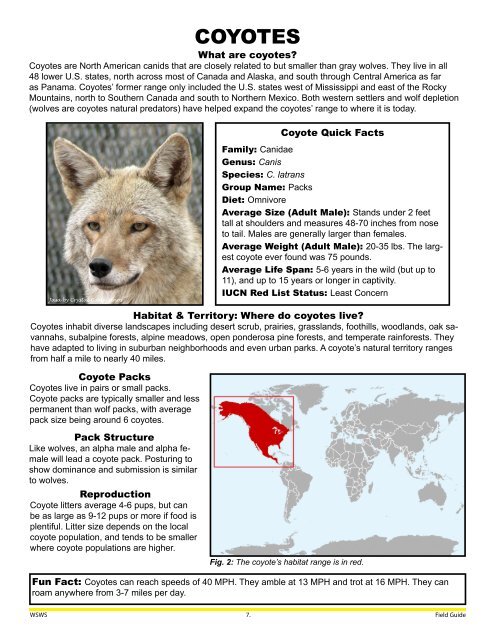Wild Spirit Wolf Sanctuary Educational Field Guide
Wild Spirit Wolf Sanctuary’s Student Field Guide provides readers with in depth details on the species of wild canids our Sanctuary houses, including their physical characteristics, behaviors, similarities and differences, territory, endangered species status, and the important functions these animals play in their native ecosystems. We hope you have a howling good time reading our Field Guide!
Wild Spirit Wolf Sanctuary’s Student Field Guide provides readers with in depth details on the species of wild canids our Sanctuary houses, including their physical characteristics, behaviors, similarities and differences, territory, endangered species status, and the important functions these animals play in their native ecosystems. We hope you have a howling good time reading our Field Guide!
You also want an ePaper? Increase the reach of your titles
YUMPU automatically turns print PDFs into web optimized ePapers that Google loves.
COYOTES<br />
What are coyotes?<br />
Coyotes are North American canids that are closely related to but smaller than gray wolves. They live in all<br />
48 lower U.S. states, north across most of Canada and Alaska, and south through Central America as far<br />
as Panama. Coyotes’ former range only included the U.S. states west of Mississippi and east of the Rocky<br />
Mountains, north to Southern Canada and south to Northern Mexico. Both western settlers and wolf depletion<br />
(wolves are coyotes natural predators) have helped expand the coyotes’ range to where it is today.<br />
Jasa by Crystal Castellanos<br />
Coyote Quick Facts<br />
Family: Canidae<br />
Genus: Canis<br />
Species: C. latrans<br />
Group Name: Packs<br />
Diet: Omnivore<br />
Average Size (Adult Male): Stands under 2 feet<br />
tall at shoulders and measures 48-70 inches from nose<br />
to tail. Males are generally larger than females.<br />
Average Weight (Adult Male): 20-35 lbs. The largest<br />
coyote ever found was 75 pounds.<br />
Average Life Span: 5-6 years in the wild (but up to<br />
11), and up to 15 years or longer in captivity.<br />
IUCN Red List Status: Least Concern<br />
Habitat & Territory: Where do coyotes live?<br />
Coyotes inhabit diverse landscapes including desert scrub, prairies, grasslands, foothills, woodlands, oak savannahs,<br />
subalpine forests, alpine meadows, open ponderosa pine forests, and temperate rainforests. They<br />
have adapted to living in suburban neighborhoods and even urban parks. A coyote’s natural territory ranges<br />
from half a mile to nearly 40 miles.<br />
Coyote Packs<br />
Coyotes live in pairs or small packs.<br />
Coyote packs are typically smaller and less<br />
permanent than wolf packs, with average<br />
pack size being around 6 coyotes.<br />
Pack Structure<br />
Like wolves, an alpha male and alpha female<br />
will lead a coyote pack. Posturing to<br />
show dominance and submission is similar<br />
to wolves.<br />
Reproduction<br />
Coyote litters average 4-6 pups, but can<br />
be as large as 9-12 pups or more if food is<br />
plentiful. Litter size depends on the local<br />
coyote population, and tends to be smaller<br />
where coyote populations are higher.<br />
Fig. 2: The coyote’s habitat range is in red.<br />
Fun Fact: Coyotes can reach speeds of 40 MPH. They amble at 13 MPH and trot at 16 MPH. They can<br />
roam anywhere from 3-7 miles per day.<br />
WSWS 7. <strong>Field</strong> <strong>Guide</strong>


